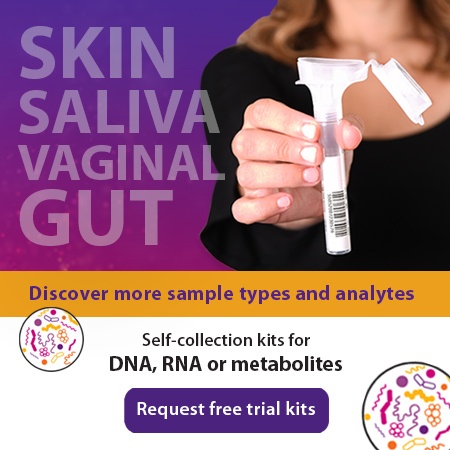2015-05-26

Update: Since this interview with the Weizmann Institute, the results of the Personalized Nutrition Project have been published in the journal Cell: “Personalized Nutrition by Prediction of Glycemic Responses”.
We sat down with Adina Weinberger from the Weizmann Institute to discuss her research in the microbiome field and her experience with using the OMNIgene●GUT collection and stabilization device. Adina and her team at Weizmann started a research project called the Personalized Nutrition Project (PNP). In this project the blood glucose levels of healthy individuals are monitored over the course of a week and a fecal sample is collected from each participant once during the week. To date they have tested ~800 people and their goal is to include 1000 participants. The team wants to understand the relationship between specific patterns of blood glucose levels and the microbiome of a given individual to determine if there are global rules or trends that emerge.
Personalized Nutrition Project (PNP)
Microbiome epidemiology studies are very challenging to execute. As a leader in this area could you share your experience in establishing efficient workflows from collection to result?
The most important reason we’ve connected to your product is for the collection. The collection stage in the workflow is the weak link and it is important to us at the Weizmann institute to have standardization because this type of test is done in the privacy of the homes of the user and as a research centre we cannot monitor anything. We want the collection to be as good as possible. I think collection is the most important thing to have and when you analyze the sample, the microbiome profile should be as close as possible to when the sample was given. I’d like to mention that before we started using DNA Genotek’s collection and stabilization kit (OMNIgene●GUT) we used swabs which was standard procedure in this field. We noticed that when we used swabs, although we were very strict in our collection procedure, providing coolers to our users and freezing the samples immediately in -80°C freezers, we noticed in some of the swabs there was some overgrowth of bacteria on the swab after collection.
What are the main challenges your team has faced in executing this kind of project?
The collection as I mentioned was very difficult, but the other thing is growing from a pilot to a large scale experiment. We are dealing with large amounts of samples and we are running DNA purifications and so for all of these steps we had to develop automation pipelines from the collection step to purified DNA to the sequencing (metagenome sequencing). This development of automation pipelines was a challenge that took us several months to complete.
Did you find the protocols any easier using our product vs swabs?
Yes, actually. What makes your product easier is that the sample is already dissolved in liquid. If you would like to, you could do the entire automated process and put it in your robot (we don’t) since the sample is already suspended in liquid. If you’re using swabs it requires manual steps which take a lot of time. I can tell you that the manual part takes 1/3 of the time of the entire DNA purification when you are using swabs, so we’ve made our lab efficiency about 30% better by eliminating manual steps with your product.
You recently adopted OMNIgene●GUT as a device for collection and stabilization of your fecal samples. What are the features or benefits that helped you in choosing this technology for your project? What feedback can you provide on your experience with the product?
Our users liked the OMNIgene●GUT collection kits that we gave them. In the lab, the fact that there is something in the buffer that is dissolving the dried samples to make it more of a liquid is a benefit. The most important thing is the stability of the DNA. When we purify DNA from those samples we can see that the DNA that comes out is of high molecular weight. This is very important to us. There is almost no degradation of DNA compared to other types of collection (most of our experience is with swabs). Our DNA purification with swabs was good but it is much better with your OMNIgene●GUT collection kits. Those are two major things 1) There is no DNA degradation and 2) You can get more DNA per sample
What role do you think the sample plays in the process and to the quality of your results?
The sample plays a major role because many people in the field can see that the microbiome can look very unstable and it can be very hard to compare between people and you see many, many, differences. Many of the differences are actually noise coming from the way you collect the sample. Bacteria can grow on the sample so we’ve put major resources around the collection. We are sending coolers (it doesn’t matter but we are still sending them) and we give strict instructions to the users to freeze the samples so there is no growth in it. We believe that a lot of the noise can come from inadequate or non-standardized sample collection procedures.
What are some important tips you could suggest for researchers trying to expand their projects from pilot stage to larger population studies?
I would divide it into two. The first part would be the connection with people you want to monitor in recruitment. In our study we are interested in recruiting healthy people so we are not connected to a clinic. If you are connected with a clinic and you are interested in people with a specific illness that would be easier. However, for us looking for healthy people, this part of recruitment was a challenge and after the recruitment we need to have people cooperate with us and agree to all of our many requests from our cohort. So for recruitment you should treat it like you are selling some kind of product. You really want to make people want to be part of your study and motivate them.
The other part as I see it is an automated lab would help a lot. We are working with a robot in the lab to facilitate work with a large amount of samples. So it is important to have automated tools at your hands and the entire project on all its aspects must be managed using computational tools. You cannot manage it only with excel. You need very good managing software to work with the huge information set that you are collecting and to help organize the data and not lose anything.
Where do you think microbiome research is heading and what future applications do you see coming from it?
The gut microbiome is a special kind of community, it is comprised of bacteria but it also includes many phages and viruses. All of these organisms live together in a confined environment that is the gut, and affect the growth of each other. They also exchange genetic material in all sorts of ways. Thus, the data that will emerge from metagenome sequencing of gut microbiome could be valuable for studies in evolution of species as well as for the clinical studies such as ours. Another important point about the microbiome is that it has a lot of information and may be important for diagnostics. In future prospective studies, the rich data coming from the ‘omics’ of gut microbiome (metagenome, metabolome, etc.) may be used to develop computational tools for diagnosis and prediction of diesis development such as diabetes and cancer. The other thing that I see coming is that we are already very convinced that the microbiome is an image of our nutrition but it also affects the food that we select to eat and what we finally absorb in the gut. The gut microbiome is 1.5kg’s on average in people, so you can think of it like a kind of organ. You live with this huge amount of bacteria in you and it affects your health and nutrition. Our body’s organs are very difficult to replace, but we know now that we can change the composition of our gut microbiota with diet, and with that hopefully improve our health. We are convinced the microbiome is affected by our nutrition and life style and it is important to understand the interplay between the microbiome and the physiology of our bodies. I hope that our study and others will help us understand what is a ‘healthy’ microbiome and how to stabilize a healthy microbial community in our gut.
If you had to guess, how long before microbiome information is implemented into clinical practice to give people recommendations on health? (5yrs out? 10yrs out?)
5 years out. It tells us a lot. We don’t know yet because this is exactly what we are trying to find out and we have to collect all the data to be able to find this out. I strongly believe it’s going to become a tool to help us diagnose diesis and design specific diets.
We thank Adina for her time and sharing with us the Weizmann Institute’s experience with the use of OMNIgene●GUT in her microbiome study. We look forward to seeing the results of the Personalized Nutrition Project upon completion of the study.
The Weizmann institute also shared some of their donor feedback from the usability of the OMNIgene●GUT device. The results of the survey showed that 90% of donors indicated OMNIgene●GUT was very easy to use (4 or 5 on scale).
Key takeaways
- Automation pipeline is needed when growing from a pilot study to a large scale study
- Proper collection and stabilization of the sample is key to ensure the microbiome profile is representative of the in vivo state.
- Liquefied microbiome sample allows for automation and significantly increases workflow efficiency
- High molecular weight DNA with OMNIgene●GUT
- For recruitment in a microbiome study you need to motivate people to be part of your study.


